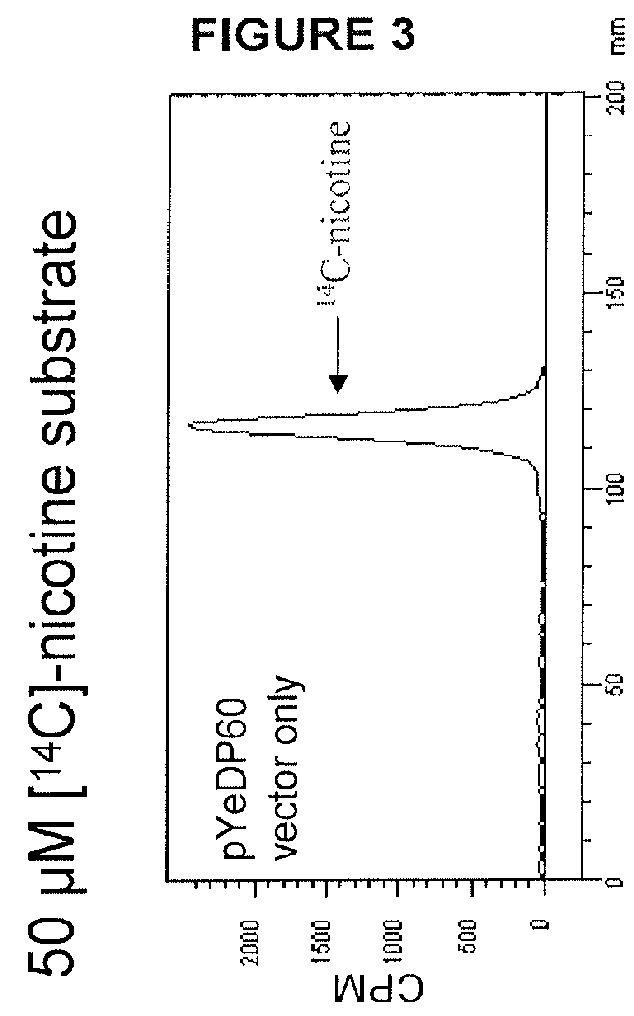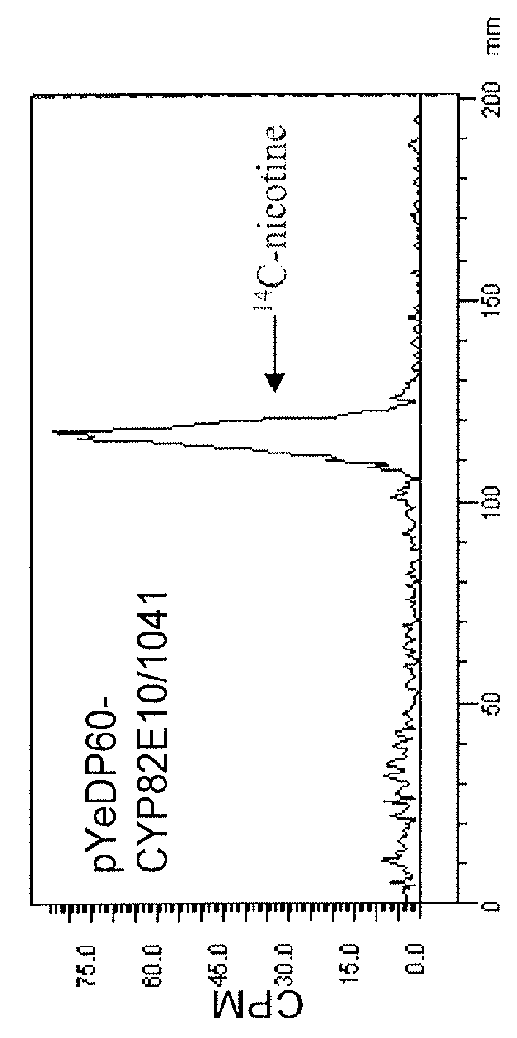Compositions and methods for minimizing nornicotine synthesis in tobacco
a technology of nornicotine and tobacco, applied in the field of compositions and methods for minimizing nornicotine synthesis, can solve the problems of reducing the effect of nicotine conversion rate, reducing the carcinogenic potential of tobacco products, and reducing so as to reduce the rate of conversion of nicotine, reduce the level of nornicotine, and reduce the effect of tobacco product carcinogenic potential
- Summary
- Abstract
- Description
- Claims
- Application Information
AI Technical Summary
Benefits of technology
Problems solved by technology
Method used
Image
Examples
example 1
Isolation and Characterization of the cyp82e10 Nicotine Demethylase Gene
[0208]To identify other genes in the tobacco genome that have the potential of encoding nicotine demethylase enzymes, homology searches using the BLASTN and BLASTX algorithms (Altschul et al., 1990, 1997) were directed against the N. tabacum expressed sequenced tagged (EST) databases in GenBank, using the DNA and protein sequences of CYP82E4v2 as the respective query sequences. In addition to identifying cDNA sequences corresponding to previously characterized members of the CYP82E superfamily (such as CYP82E2, CYP82E3 and CYP82E5v2), seven ESTs were discovered that did not align perfectly with any previously characterized member of this gene family. Interestingly, all seven of the ESTs originated from either root-specific cDNA libraries, or cDNA libraries made up of mixed tissues that included roots. This observation suggested that the new CYP82E gene is expressed specifically in root tissue, a property that co...
example 2
Identification of Plants Possessing Mutant Alleles of CYP82E10
[0213]In order to accurately assess the specific contribution of CYP82E10 toward the total nornicotine content of the tobacco plant, it was necessary to: (1) identify a tobacco plant with a knockout mutation within this gene; and (2) combine this mutation with the cyp82e4v2 and cyp82e5v2 mutations originating from plants 775 and 1013, respectively. To identify potentially debilitating mutations in CYP82E10, the EMS-mutagenized DH98-325-6 population was screened by high-throughput DNA sequence analysis using primers that specifically amplify portions of CYP82E10 (without simultaneously amplifying other members of the CYP82E superfamily). To specifically amplify exon 1 of CYP82E10, the following PCR primers were used: 5′-GTGATAGTTTGATTCCCAAGTGC-3′ (forward) and 5′-CTCCCAAAGTTAGATTAGTCCG-3′ (reverse); specific amplification of exon 2 was achieved using the primers 5′-AGGTCGCGCTGATTCTTG-3′ (forward) and 5′-AGATGAATACCCATCTATC...
example 3
Combining Mutant Alleles of cyp82e10, cyp82e4v2 and cyp82e5v2
[0219]Given that the original 1041 mutation is in a genetic background (DH98-325-6) that contains both a strong converter CYP82E4v2 allele as well as a wild type CYP82E5v2 gene, the only way to accurately assess the specific contribution of CYP82E10 toward total plant nornicotine content is to introduce the 1041 mutation into tobacco plants possessing knockout CYP82E4v2 and CYP82E5v2 mutations as well. To accomplish this, plants heterozygous for the 1041 mutation (e10E10) were crossed with plants heterozygous for both the 775 and 1013 mutations described above (e4E4 / e5E5). The latter plants represent progeny of from the cross 775 / 1013 / / TN90 / 3 / TN90 / 4 / TN90. F1 plants heterozygous for all three nicotine demethylase mutations (e4E4 / e5E5 / e10E10) were identified by molecular genotyping, and allowed to self-pollinate. Molecular genotyping was also used to screen over 400 F2 progeny and subsequently group them into the following g...
PUM
| Property | Measurement | Unit |
|---|---|---|
| temperature | aaaaa | aaaaa |
| pH | aaaaa | aaaaa |
| Tm | aaaaa | aaaaa |
Abstract
Description
Claims
Application Information
 Login to View More
Login to View More - R&D
- Intellectual Property
- Life Sciences
- Materials
- Tech Scout
- Unparalleled Data Quality
- Higher Quality Content
- 60% Fewer Hallucinations
Browse by: Latest US Patents, China's latest patents, Technical Efficacy Thesaurus, Application Domain, Technology Topic, Popular Technical Reports.
© 2025 PatSnap. All rights reserved.Legal|Privacy policy|Modern Slavery Act Transparency Statement|Sitemap|About US| Contact US: help@patsnap.com



